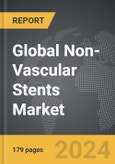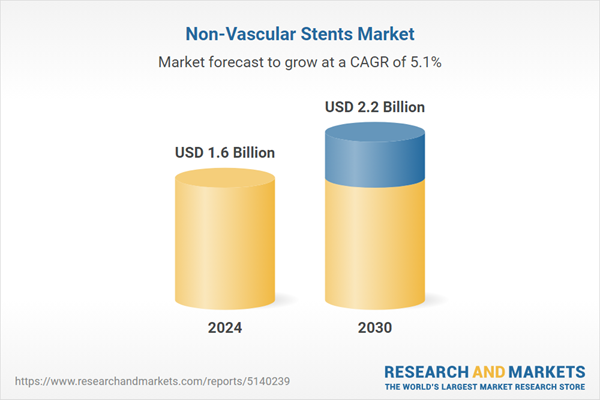The global market for Non-Vascular Stents was valued at US$1.6 Billion in 2024 and is projected to reach US$2.2 Billion by 2030, growing at a CAGR of 5.1% from 2024 to 2030. This comprehensive report provides an in-depth analysis of market trends, drivers, and forecasts, helping you make informed business decisions. The report includes the most recent global tariff developments and how they impact the Non-Vascular Stents market.
Segments: Product Type (Urology Stents, Gastrointestinal Stents, Pulmonary Stents, Other Product Types).
Geographic Regions/Countries: World; United States; Canada; Japan; China; Europe (France; Germany; Italy; United Kingdom; and Rest of Europe); Asia-Pacific; Rest of World.
The analysts continuously track trade developments worldwide, drawing insights from leading global economists and over 200 industry and policy institutions, including think tanks, trade organizations, and national economic advisory bodies. This intelligence is integrated into forecasting models to provide timely, data-driven analysis of emerging risks and opportunities.
Global Non-Vascular Stents Market - Key Trends & Drivers Summarized
What Are Non-Vascular Stents and Why Are They Crucial for Patient Care?
Non-vascular stents are medical devices used to support and keep open passageways in non-vascular systems, such as the digestive, urinary, and respiratory tracts. These stents are primarily used to treat obstructions caused by tumors, strictures, or other blockages in organs such as the esophagus, bile ducts, ureters, and airways. Unlike vascular stents, which are used in arteries and veins, non-vascular stents focus on relieving obstructions in soft tissue organs, ensuring normal bodily functions like breathing, urination, or digestion are maintained. Materials used for non-vascular stents range from metal alloys to biodegradable polymers, allowing for tailored solutions based on the patient’s specific condition. The use of non-vascular stents has become increasingly important in palliative care for patients with cancers that lead to blockages in these systems.How Are Technological Advancements Revolutionizing the Non-Vascular Stents Market?
The non-vascular stents market has seen significant innovation in recent years, particularly with the development of advanced materials and stent designs. Biodegradable stents, which dissolve after a certain period, are gaining traction as they reduce the need for repeat procedures to remove the stent. Additionally, drug-eluting stents, which slowly release medication to prevent tissue inflammation or growth around the stent, are becoming more widely adopted. Improvements in stent flexibility and the development of self-expanding stents have enhanced the ease of implantation and reduced procedural risks. These technological advancements allow for more precise and less invasive treatment of blockages, improving patient outcomes and recovery times. As minimally invasive procedures gain popularity, non-vascular stents are increasingly being deployed as a solution for a range of conditions, particularly in patients who are not ideal candidates for more invasive surgeries.How Are Demographic and Healthcare Trends Impacting the Non-Vascular Stents Market?
The rising incidence of diseases such as cancer, gastrointestinal disorders, and chronic obstructive pulmonary disease (COPD) is one of the primary drivers of demand for non-vascular stents. With aging populations across the globe, there is an increasing prevalence of conditions that lead to obstructions in the biliary, urinary, and respiratory tracts. This demographic shift is creating sustained demand for stenting procedures as part of both palliative and curative care. Moreover, advancements in healthcare infrastructure, particularly in emerging markets, have expanded access to medical devices such as non-vascular stents, increasing their adoption in regions previously underserved by medical technology. Additionally, the growing emphasis on patient comfort and quality of life, particularly in oncology, has led to a greater reliance on non-vascular stents as a solution to alleviate symptoms caused by obstructions.What Factors Are Driving Growth in the Non-Vascular Stents Market?
The growth in the non-vascular stents market is driven by several factors. Technological advancements, such as the development of self-expanding and drug-eluting stents, are enhancing treatment outcomes and reducing complications, which in turn is driving wider adoption of these devices. The increasing prevalence of cancer and chronic diseases, particularly in aging populations, is also fueling demand for non-vascular stents as an essential part of palliative care. Furthermore, the shift toward minimally invasive procedures is driving the adoption of stents over more invasive surgical options, particularly for elderly patients or those with severe conditions. Expanding healthcare access in emerging markets, combined with growing investments in medical infrastructure, is opening up new opportunities for the non-vascular stents market. Finally, the trend toward personalized medicine, with customized stent designs for specific patient needs, is further bolstering market growth.Report Scope
The report analyzes the Non-Vascular Stents market, presented in terms of units. The analysis covers the key segments and geographic regions outlined below.Segments: Product Type (Urology Stents, Gastrointestinal Stents, Pulmonary Stents, Other Product Types).
Geographic Regions/Countries: World; United States; Canada; Japan; China; Europe (France; Germany; Italy; United Kingdom; and Rest of Europe); Asia-Pacific; Rest of World.
Key Insights:
- Market Growth: Understand the significant growth trajectory of the Urology Stents segment, which is expected to reach US$1.1 Billion by 2030 with a CAGR of a 5.1%. The Gastrointestinal Stents segment is also set to grow at 5.3% CAGR over the analysis period.
- Regional Analysis: Gain insights into the U.S. market, valued at $445.9 Million in 2024, and China, forecasted to grow at an impressive 4.9% CAGR to reach $347.3 Million by 2030. Discover growth trends in other key regions, including Japan, Canada, Germany, and the Asia-Pacific.
Why You Should Buy This Report:
- Detailed Market Analysis: Access a thorough analysis of the Global Non-Vascular Stents Market, covering all major geographic regions and market segments.
- Competitive Insights: Get an overview of the competitive landscape, including the market presence of major players across different geographies.
- Future Trends and Drivers: Understand the key trends and drivers shaping the future of the Global Non-Vascular Stents Market.
- Actionable Insights: Benefit from actionable insights that can help you identify new revenue opportunities and make strategic business decisions.
Key Questions Answered:
- How is the Global Non-Vascular Stents Market expected to evolve by 2030?
- What are the main drivers and restraints affecting the market?
- Which market segments will grow the most over the forecast period?
- How will market shares for different regions and segments change by 2030?
- Who are the leading players in the market, and what are their prospects?
Report Features:
- Comprehensive Market Data: Independent analysis of annual sales and market forecasts in US$ Million from 2024 to 2030.
- In-Depth Regional Analysis: Detailed insights into key markets, including the U.S., China, Japan, Canada, Europe, Asia-Pacific, Latin America, Middle East, and Africa.
- Company Profiles: Coverage of players such as BARD, A Becton, Dickinson Company, Boston Scientific Corporation, ConMed Corporation, Cook Medical, Inc., ELLA-CS, s.r.o. and more.
- Complimentary Updates: Receive free report updates for one year to keep you informed of the latest market developments.
Some of the 11 companies featured in this Non-Vascular Stents market report include:
- BARD, A Becton, Dickinson Company
- Boston Scientific Corporation
- ConMed Corporation
- Cook Medical, Inc.
- ELLA-CS, s.r.o.
- Glaukos Corporation
- Hobbs Medical, Inc.
- Medtronic PLC
- Synchron, Inc.
- Taewoong Medical
Tariff Impact Analysis: Key Insights for 2025
Global tariff negotiations across 180+ countries are reshaping supply chains, costs, and competitiveness. This report reflects the latest developments as of April 2025 and incorporates forward-looking insights into the market outlook.The analysts continuously track trade developments worldwide, drawing insights from leading global economists and over 200 industry and policy institutions, including think tanks, trade organizations, and national economic advisory bodies. This intelligence is integrated into forecasting models to provide timely, data-driven analysis of emerging risks and opportunities.
What’s Included in This Edition:
- Tariff-adjusted market forecasts by region and segment
- Analysis of cost and supply chain implications by sourcing and trade exposure
- Strategic insights into geographic shifts
Buyers receive a free July 2025 update with:
- Finalized tariff impacts and new trade agreement effects
- Updated projections reflecting global sourcing and cost shifts
- Expanded country-specific coverage across the industry
Table of Contents
I. METHODOLOGYII. EXECUTIVE SUMMARY2. FOCUS ON SELECT PLAYERSIII. MARKET ANALYSISIV. COMPETITION
1. MARKET OVERVIEW
3. MARKET TRENDS & DRIVERS
4. GLOBAL MARKET PERSPECTIVE
UNITED STATES
CANADA
JAPAN
CHINA
EUROPE
FRANCE
GERMANY
ITALY
UNITED KINGDOM
REST OF EUROPE
ASIA-PACIFIC
REST OF WORLD
Companies Mentioned (Partial List)
A selection of companies mentioned in this report includes, but is not limited to:
- BARD, A Becton, Dickinson Company
- Boston Scientific Corporation
- ConMed Corporation
- Cook Medical, Inc.
- ELLA-CS, s.r.o.
- Glaukos Corporation
- Hobbs Medical, Inc.
- Medtronic PLC
- Synchron, Inc.
- Taewoong Medical
Table Information
| Report Attribute | Details |
|---|---|
| No. of Pages | 179 |
| Published | April 2025 |
| Forecast Period | 2024 - 2030 |
| Estimated Market Value ( USD | $ 1.6 Billion |
| Forecasted Market Value ( USD | $ 2.2 Billion |
| Compound Annual Growth Rate | 5.1% |
| Regions Covered | Global |









